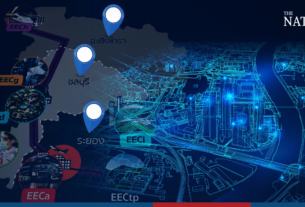THAILAND – ENERGY
PFI – Hongsa to light up Laos
One of largest single power financings in Asia – Latest in a long line of Lao-Thai deals
Banpu Power and Ratchaburi Electricity Generating Holding Public Company are about to complete the final touches to a massive US$2.7bn debt facility for their US$3.71bn Hongsa lignite coal power plant in Laos. Thai banks, and possibly Chinese banks, are signing the deal shortly. The project involves the construction of a 1,800MW power plant consisting of three units of 600MW each, which are scheduled for completion in March, August and December 2015. It is located in the Hongsa
The project will supply a major portion of the power generated to
A 25-year power purchase agreement was signed late last year between the Electricity Generating Authority of Thailand (Egat) and the project company. Egat has agreed to purchase 1,473MW from the plant in accordance with the tariff MoU signed in May 2009. About 100MW of power will be sold to Electricite du Laos for domestic consumption, to give a boost to local socio-economic development. The remaining power will be used by the project for internal mining and power generating operations.
The Hongsa project involves a mining facility for lignite, which will be used to fuel the power plant. The mining plant is called Phu Fai Mining Co, which is estimated to require US$400m to US$500m of the total project cost. LHSE will have a 25% share in the lignite mine and Banpu and Ratch will each hold 37.5% stakes.
The total project cost is about US$3,710m and this will be raised on a 75:25 debt to equity ratio. The project cost will also be divided into US dollars (50%) and Thai baht (50%). This includes the debt portion of US$2.7bn which will be two-thirds in Thai baht and one-third in US dollars. The tenor of the loan is about 18 years, with a construction period of five years. The loan repayment starts one year from commencement of operations. The margins are on a step-up and step-down structure.
The loan is divided into four tranches that include construction costs, interest during construction and others. It is dominated by Thai banks, which will be signing the loan shortly. There are nine banks that have committed to the deal. Financial adviser is Bangkok Bank and joining it are Bank of Ayudhya, Government Savings Bank, Kasikorn Bank, Krung Thai Bank,
The sponsors and the adviser are in talks with some Chinese banks that may join at a later date. They include Bank of China,
The project has met protests from environmentalists and from local residents. According to local reports, about 2,000 villagers are planning to intensify their campaign against the lignite mining project, which they claim could lead to widespread pollution. They apparently have erected protest banners and posters in front of houses and schools and along streets in the area.
The high construction and funding costs in the past two years have pushed back projects to the backburner. The global financial crisis made it worse and put a dent in the demand for power, resulting in further delay in the construction of the plants.
With the improvement in the economy and with the Hongsa plant about to obtain its massive funds, the other projects are now expected to follow suit. Egat previously signed memoranda of understanding for purchases of power from four hydropower developers in Laos, and some of these are about to be revived. They include the 278MW Nam Ngiep, 440MW Nam Ngum 3, the 523MW Nam Theun 1 and the Theun-Hinboun expansion phase and Nam Ou.

